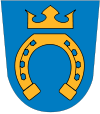Espoo
| Espoo Espoon kaupunki - Esbo stad |
|||
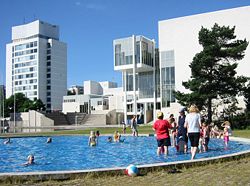 |
|||
|
|||
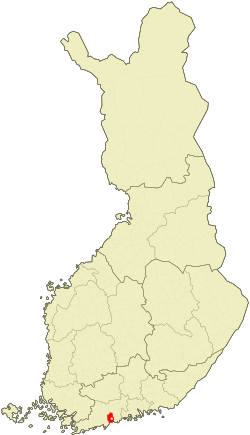 |
|||
| Coordinates: | |||
| Country | Finland | ||
|---|---|---|---|
| Province | Southern Finland | ||
| Region | Uusimaa | ||
| Sub-region | Greater Helsinki | ||
| Charter | 1972 | ||
| Government | |||
| - City manager | Marketta Kokkonen | ||
| Area | |||
| - Total | 528 km² (203.9 sq mi) | ||
| - Land | 312 km² (120.5 sq mi) | ||
| - Water | 216 km² (83.4 sq mi) | ||
| Population (2008) | |||
| - Total | 240,132 | ||
| - Density | 753/km² (1,950.3/sq mi) | ||
| Time zone | EET (UTC+2) | ||
| - Summer (DST) | EEST (UTC+3) | ||
| Official languages | Finnish (84,8 %), Swedish (8,5 %) | ||
| Website: www.espoo.fi | |||
Espoo (IPA: [ˈespoː]; Esbo ([ˈɛsbo]) in Swedish) is the second largest city of Finland, with a population of approximately 240,000. It is part of the Helsinki Metropolitan Area along with the cities of Helsinki, Vantaa, and Kauniainen. Espoo shares its eastern border with Helsinki and Vantaa, while enclosing Kauniainen. Other bordering municipalities are Nurmijärvi and Vihti in the north and Kirkkonummi in the west. The national park of Nuuksio is situated in northwest Espoo.
Espoo encompasses 528 km², of which 312 km² are land. The current population is 240,132 (as of 2008-07-31), in Finland second only to that of Helsinki.
Espoo has several local regional centers. Espoo is thus divided into the following major areas: Espoon keskus (also administrative center), Espoonlahti, Kalajärvi, Kauklahti, Leppävaara, Matinkylä-Olari, and Tapiola.
The Helsinki University of Technology is based in Otaniemi, Espoo, along with a thriving science community that includes numerous startups and organizations such as VTT–the Technical Research Center of Finland. Nokia, the telecommunications company, operates from Keilaniemi (and also from Karamalmi), Espoo, along with other high-tech companies such as KONE and Fortum.
Contents |
History
The name Espoo probably comes from the Swedish name for the River Espoo, Espå (or Espåå), which in turn comes from the old Swedish word äspe, meaning stand of aspen, and the Swedish word for "river", å. The name was first mentioned in 1431.
The first inhabitants in the area arrived about 9,000 years ago. A permanent settlement was established during the 12th and 13th centuries. The King’s Road that passes through Espoo on its way from Stockholm via Turku to Viipuri dates back to the 13th century. The oldest preserved building in Espoo, the Espoo Cathedral, originates from the 1480s. The administrative center Espoon keskus has grown around the church and the railway station.
In 1920, Espoo was only a rural municipality of about 9,000 inhabitants, of whom 70% were Swedish speaking. Agriculture was the primary source of income, with 75% of the population making their living from farming. Kauniainen (Grankulla in Swedish) was separated from Espoo in 1920, and it gained city rights the same year as Espoo, in 1972.
Espoo started to grow rapidly in the 1940s and '50s. It quickly developed from a rural municipality into a fully-fledged industrial city, gaining city rights in 1972. Due to its proximity to Helsinki, Espoo soon became popular amongst people working in the capital. In the fifty years from 1950 to 2000, the population of Espoo grew from 22,000 to 210,000. Since 1945, the majority of people in Espoo have been Finnish speaking. In 2006, the Swedish speaking inhabitants represented barely 9% of the total population. The population growth is still continuing, but at a slower rate.
Demographics
| Historical population of Espoo[1] | |||
|---|---|---|---|
| Year | Population | Year | Population |
| 1901 | 5,888 | 1975 | 120,632 |
| 1910 | 7,891 | 1980 | 137,409 |
| 1920 | 8,817 | 1985 | 156,778 |
| 1930 | 11,370 | 1990 | 172,629 |
| 1940 | 13,378 | 1995 | 193,754 |
| 1950 | 22,878 | 2000 | 213,271 |
| 1960 | 53,042 | 2006 | 235,019 |
| 1970 | 92,655 | 2030 (est.) | 305,000 |
| Population by grand district (in 2006) | |||
| Area | Population | Area | Population |
| Leppävaara | 58,048 | Vanha-Espoo | 33,613 |
| Espoonlahti | 48,649 | Pohjois-Espoo | 9,754 |
| Tapiola | 41,905 | Kauklahti | 6,191 |
| Matinkylä | 33,613 | ||
Population by nationality on January 1 2007 was 95.1% Finnish nationality, 4.9% other nationalities. Religious affiliation was 77.4% Lutheran, 1.3% Orthodox, 1.3% other, 19.9% no religious affiliation.
Espoo contains many high income suburbs, six out of the ten highest average income zip code areas in Finland are in Espoo.
Culture
The Melodic Death Metal band Children of Bodom comes from Espoo, Finland. They are named after the mass murder known as the Lake Bodom murders which took place at Lake Bodom, a lake in northern Espoo. The bands Norther and Kiuas also come from Espoo.
Sports
Espoo is home to several premier league sports teams. The Espoo Blues play at LänsiAuto Areena in the SM-Liiga - professional ice hockey league. The club was established in February 1984 as "Kiekko-Espoo" and played their first season in 1984-1985 in the Finnish Second Division. In 1988 they achieved a place on the Finnish First Division and in 1992 they celebrated their promotion to the SM-liiga. The club and the team changed their name in 1998. The name came from the dominant colour of their home jersey. The full name of the club is Blues Hockey Oy.
Another sports club from Espoo, FC Honka, is a football club based in Tapiola in southern Espoo. It was promoted into the Finnish premier division (Veikkausliiga) for the first time in its history at the end of the 2005 season. The manager of the club is Mika Lehkosuo, and it plays its home matches at Tapiolan urheilupuisto. Originally founded in 1953 as "Tapion Honka", it changed its name into FC Honka in 1975. FC Honka is largely known in Finland for its extensive youth scheme with over 1000 young players playing in various age groups.
Espoo is the birthplace of 2000 and 2002 World Rally Champion Marcus Grönholm, 2007 Formula One Champion Kimi Räikkönen, Dallas Stars forward Jere Lehtinen (three time NHL Selke Trophy winner), and JJ Lehto.
| Club | Sport | League | Stadium | Logo |
| Espoo Blues | Ice hockey | SM-liiga | LänsiAuto Areena | |
| Espoo Blues | Ice hockey | Women's SM series | Laaksolahti Arena | |
| FC Honka | Football | Veikkausliiga | Tapiolan urheilupuisto | |
| Tapiolan Honka | Basketball | Korisliiga | Tapiolan urheiluhalli | |
| Espoon Oilers | Floorball | Salibandyliiga | Tapiolan urheiluhalli |
Gallery
Sister cities
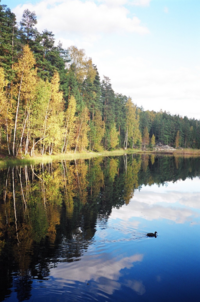
 Esztergom, Hungary
Esztergom, Hungary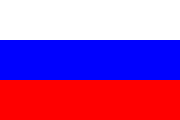 Gatchina, Russia
Gatchina, Russia Irving, United States
Irving, United States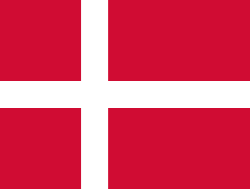 Køge, Denmark
Køge, Denmark Kongsberg, Norway
Kongsberg, Norway Kristianstad, Sweden
Kristianstad, Sweden Nõmme, Estonia
Nõmme, Estonia Sauðárkrókur, Iceland
Sauðárkrókur, Iceland Shanghai, China
Shanghai, China Sochi, Russia
Sochi, Russia
References
- Espoon kaupungin taskutilasto 2007, issued by the City of Espoo, 2007
See also
- Convention on Environmental Impact Assessment in a Transboundary Context, signed in Espoo 1991
- Districts of Espoo
External links
- (Finnish) City Website
- (English) City Website
- (English) Espoo City Travel Website
- (Finnish)/(English) Helsinki University of Technology - located in Espoo
- (Finnish)/(English) Helsinki.fi - Helsinki region in a nutshell
|
|||||||||||||||||||||||
| Municipalities of Uusimaa |  |
|
| Ekenäs | Espoo | Hanko | Helsinki | Hyvinkää | Ingå | Järvenpää | Karis | Karjalohja | Karkkila | Kauniainen | Kerava | Kirkkonummi | Lohja | Mäntsälä | Nummi-Pusula | Nurmijärvi | Pohja | Pornainen | Sammatti | Siuntio | Tuusula | Vantaa | Vihti | ||
| Uusimaa Region | Southern Finland | Finland |
